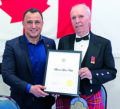General News » News
Proposed aquatics facility could cost more than $50 million
July 23, 2020 · 0 Comments
A fully-equipped aquatics facility could greatly improve service levels for sports groups and residents alike, but could come with a hefty price tag.
This month, the findings of the Town’s Aquatics Feasibility Study were formally presented to Council.
Commissioned in early 2019 as part of the Town’s overall Parks & Recreation Master Plan to examine how current Town of Aurora facilities will accommodate future growth, the study went forward on the Master Plan’s findings that a new pool of 25 metres, accommodating six lanes, would greatly improve service levels and better accommodate the needs of user groups.
Working with swim clubs such as the Aurora Ducks and other stakeholders, as well as examining similar builds elsewhere in Ontario, the study focused on several options for the Town, including a 25 m pool to be added to the Stronach Aurora Recreation Complex (SARC), as well as a more elaborate 50 m pool in a separate standalone facility elsewhere in Aurora.
“An additional 25 m pool would allow staff to increase offerings in all areas of aquatic programming [including] learn to swim and leadership development programs, leisure and lane swim, health, wellness and fitness programs, and additional practice time for stakeholders,” said Lisa Warth, Aurora’s Manager of Recreation, in her report to Council. “It would also create some capacity to accommodate pool use requests from new users such as high school swim teams and other clubs.
“A 25 m pool would not allow for optimal elite athletic development, nor hosting provincial or national competitions and the economic spin-offs, such as accommodation, food and beverage and other local purchases that come with hosting big competitions. This style of pool would be the most economical and sustainable to build from both a capital and operating perspective.”
A 25 m option with 10 lanes would allow capacity for 450 spectators and 300 competitors. A 50 m training pool option would allow for up to 600 spectators and competitors combined. A 50 m competition pool would allow for 900 spectators and 600 competitors, as well as a 25 m warm-up/cool down pool if built as part of a stand-alone facility.
“The 50 m event pool expands deck space and adds elevated spectator seating to be able to host significant regional and provincial invitational and championship events, and even small to mid-size national events,” Ms. Warth continued. “The 50 m event pool has additional potential for increased sponsorship and advertising revenue, significantly increasing the cost recovery of the overall aquatic facility. The 50 m event option also generates incremental economic impact for Aurora of over $6.6 million annually.
“This figure is based on economic impact generator models with inputs including event days, hotel nights, and other spending related to events such as meals, gas and other purchases.”
Depending on the configuration, the costs for the proposed facilities are estimated to range between $23.75 million and $54.55 million – and land would need to be purchased for each model.
Consultant Stuart Isaac presented his findings to local lawmakers last week, underscoring the impacts an aquatics facility would have on the local economy as well as on user groups of all ages who, through the course of the consultation process, outlined a number of shortcomings with existing pools and facilities.
Stakeholders requested a wider range of aquatics programs for all levels and abilities, he said, while water temperatures for swimming lessons, fitness and other forms of community programming remain a “concern.”
“We wanted to make sure we really took a look at the whole scope of program,” he said. “[We wanted to] not just understand their wish list, but with different options for expanded pool facilities, what would they commit to both in terms of time, lane space and rental revenues.”
A 25 m pool, he noted would improve lane availability, but a 50 m pool – a new facility or built onto the SARC – would meet all current and future training needs of existing user groups and opens up more space for others. A 50 m training space would also be a tourism draw as there are “limited” facilities outside Toronto, but location is key to maximizing tourism and economic revenue.
Building onto the SARC would be key in harnessing this money with two hotel facilities slated to be nearby, while a new build in the south end of Town runs the risk of Richmond Hill reaping much of the tourism and economic benefits.
“Your numbers provide a very compelling case to build a competitive swimming pool,” said Councillor Harold Kim, who questioned the consultant on how similar builds have impacted other communities.
Mr. Isaac replied the best example is the Windsor Aquatics Centre.
Council agreed, however, there is more work to be done in order to assess the situation.
“I will do some more digging [but] I am not overly confident we need this facility,” said Councillor Gallo. “Perhaps I need some more information in order to make me feel confident.”
Following Council’s receipt of the report last week, further community consultations will continue through August. A further report on aquatics is due this fall.
By Brock Weir











